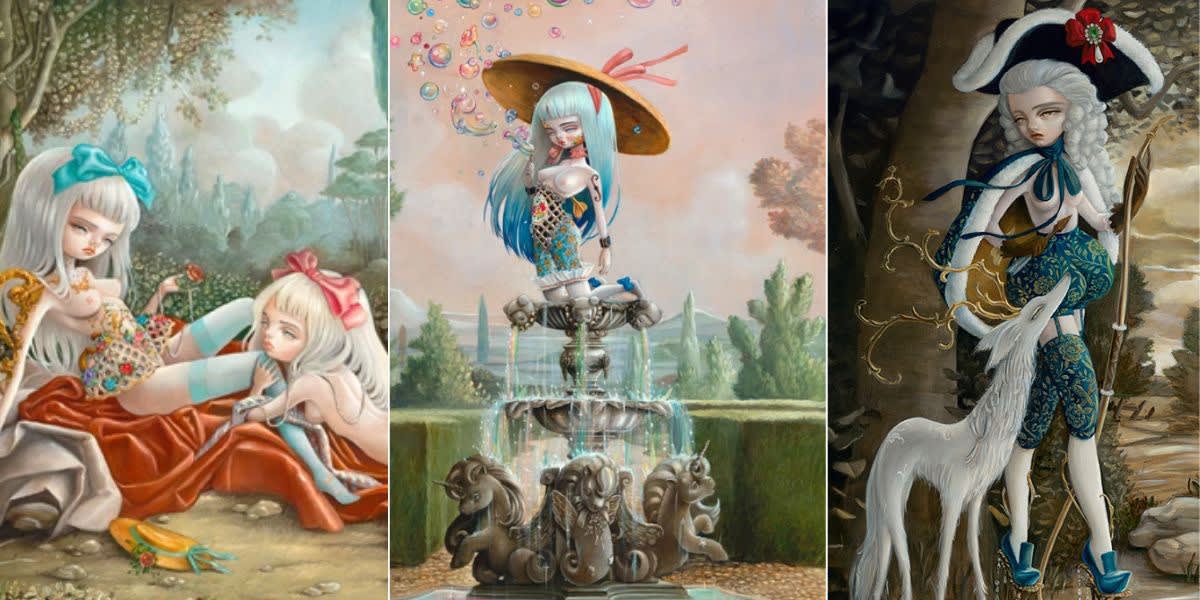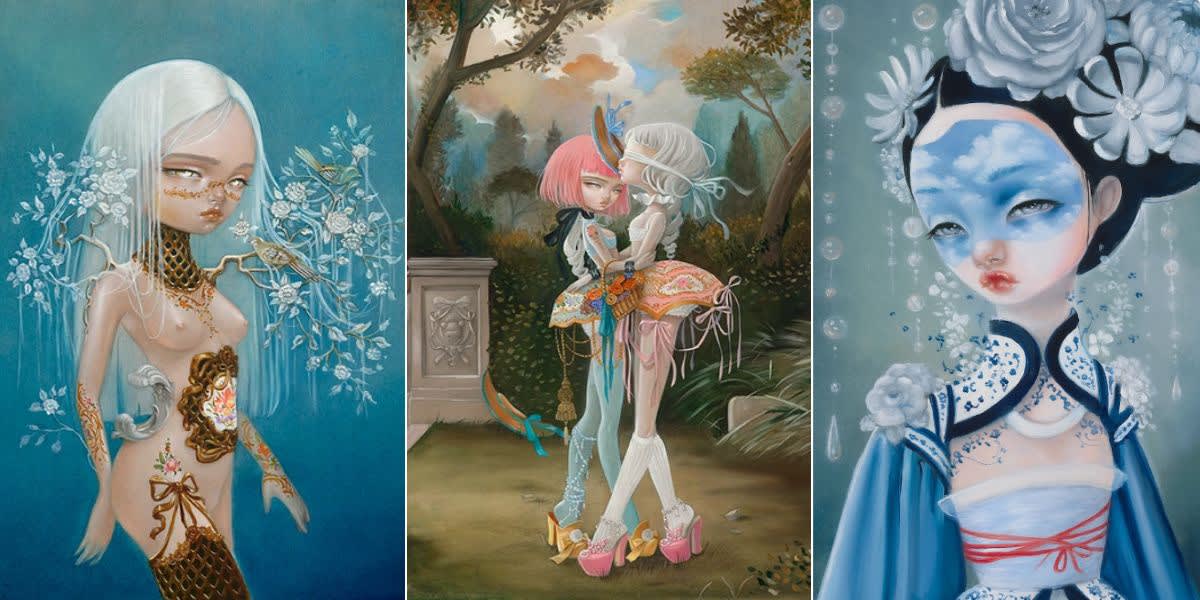


Backgrounds are not less important than the main figure or character. The frame seem to restrict the scope of the picture but the landscape or color behind the figure implies a larger world that extends beyond the frame’s borders. The world is the figure’s story, it includes history as well as the present. Time is jumbled up. Elements from social history, art history, personal history are juxtaposed with images from the present that are really like modern icons. So there’s a play between the passage of time and timelessness.
4. You create a unique blend of Pop-Rococo and contemporary surrealism, diverging from its historical roots. How do you balance these two influences, and what aspects of historical Surrealism inspire you? How does your creation of a surreality diverge from that of the traditional Surrealists?
Rococo and the classical arts were always a big love of my life since childhood. I grew up listening to operas and rewatched ballets on my VHS, obsessed with movies like Amadeus and Farinelli. Later on as a teen I discovered the surrealists and their unexpected use of images and composition. When I was twelve I asked my parents for a big Taschen Dali book for my birthday. The next year I asked for Magritte. I was drawn so strongly to both 18th century arts and modern surrealism that I made it my life effort to merge them into a thing of my own. They form the foundations of my aesthetic, along side with Japanese anime and other popular illustrations…My style slowly formed into what it is.


I’m so happy this is how you see it because its resonates so well with everything I just answered.
My goal is never to stay in a single time and place. I don’t want to capture and document a moment like a photograph. That’s death and I want infinite existence. I want us all to enjoy a sense of immortality, which is how I feel when I experience art from the past. I want the past to be in the now. By mixing icons from the present with symbols and conventions we recognize from history, time becomes free form, fluid, a blur.
8. How do you approach the use of color and light in your paintings to evoke the specific emotions and atmospheres characteristic of your style?Is there a primary color in your artistic production? A palette that reflects your artistic vision? How do you choose colors for your artworks, and what does the combination of pigments mean to you in relation to the idea and subject you're painting?
I usually work first with very earthy tones and combine with rich blues to evoke a romantic mood. I love using Terre de Castle (warm dark muddy rich brown) and Gris de Paye (dark grayish blue with red undertones) as the base of the painting.

I never thought about it, but it’s such an obvious thing I do without noticing. I think first of all I don’t want to miss on any color out there, but also I don’t want all my work to blend into one thing. I want to make sure if a collector chooses to buy a painting they get something that is absolutely one of a kind, with a completely new approach than previous pieces. Unless of course I’m making a set which is something I like to do as well some time.
10. Can you talk about the significance of the larger scales in this collection? How does working on a larger canvas affect your artistic process and the impact of the finished piece?
A large scale is always more impressive in the sense that it can overwhelm the viewer, which is what makes it possible for them to really enter the world of the painting. I used to paint very small, which can be great for phone screens, but I found that the details lost their power. The paintings felt more illustrative, the lines were thicker in proportion, the expressions felt limited and limiting. A large painting gives a proper respect for the details. It has special effect when seen in person.
11. Your art seem to often create a "secret garden" that offers solace and escape. How important is the theme of escape in your work, and what personal significance does it hold for you?
I think throughout my life I always felt like I didn’t belong. It was always a dream to create my own space. In the beginning of Alice in Wonderland, Alice sees a glimpse of the queen’s garden, which seems so perfect, so she goes on a journey to get there and when she does she realizes it is not as perfect as it seemed through the little door. I think Alice always tries to escape one situation or another, seeking the perfect garden of her dreams, just like I try to find a place where I can ignore the world around me and find perfection and peace. But it is never really reachable, reality always sneaks in.

12. How do you see the evolution of your style over the years, and what are the key influences that have shaped your artistic journey?
When I started straight out of art school, where I studied illustration and design, my concepts were straightforward and raw without much subtlety. My influences were still too apparent and had not yet been made into a personal language. With time I worked on sharpening my own artistic language and technique. My inspirations and influences are much the same but I matured in my message. The shock effect I was painting as a younger artist seems childish to me and lacking awareness because it actually obscured the most important things I needed to say.
13. Your portraits take inspiration from 1800s male portraiture, traditionally aimed at illustrating power and superiority. How did you approach transforming these elements—such as the clothing, wigs, and poses—into a feminine form, and what ideas or messages are you aiming to convey with this transformation?And does this transformation mean to challenge traditional gender norms?
When I do a research for a show, I go through my favorite painters—Boucher, Gainsborough, Reynolds, Nettier and so on. I was always a little afraid of the men’s portraits, as if they were not made for me to explore too much. I thought maybe I should go back to my usual puffy dresses and bows, but this time I decided to understand the men’s portraits more deeply—the poses, the backgrounds, the expressions—and why they made me feel this way. The outfits looks so much more comfortable than the women’s corsets which I had started to grow bored of. The wigs are soft and rest on their shoulders. I actually didn’t make too many changes but what I did change—like making the pants a two-piece with a garter, revealing the thigh—I used to show the power of the female body. A corset doest that, too, in a way but in a restrictive way. By leaving the body partially bare, vulnerable but unafraid and unapologetic, it says you have no power over me, I can take my own freedom.

